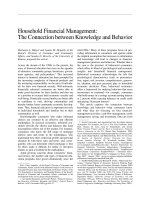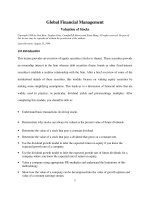Financial management
Bạn đang xem bản rút gọn của tài liệu. Xem và tải ngay bản đầy đủ của tài liệu tại đây (1.27 MB, 104 trang )
ACCA Paper F9
Financial Management
Core areas of the syllabus
•
•
•
•
•
•
•
•
Financial management function
Financial management environment
Working capital management
Investment appraisal
Business finance
Cost of capital
Business valuations
Risk management
Format of the exam
•
•
•
Four compulsory questions
25 marks each
Balance of calculative and discursive elements in questions
The financial management
function
•
•
(1) Raising finance
The financial management
function
(2) Investing funds raised – this
includes
• allocating funds and
• controlling investments
•
(3) Dividend policy – returning gains
to shareholders
Corporate strategy and
objectives
Corporate stakeholders
Agency theory
•
Agency relationships occur when one party, the principal, employs another
•
•
Objectives of principals and agents may not coincide
party, the agent, to perform a task on their behalf
Problem of goal congruence
Not for profit organisations
Value for money
•
Effectiveness
– A measure of outputs
– e.g. number of pupils taught
•
Efficiency
– A measure of outputs over inputs
– e.g. Average class size
•
Economy
– Being effective and efficient at the lowest
possible cost
System analysis
Investment appraisal
•
•
•
•
ROCE
Payback
Net present value
Internal rate of return
ROCE
Payback
Payback
The time value of money
•
Money received today is worth more than the same sum received in the future
because of:
– The potential for earning interest
– The impact of inflation
– The effect of risk
Compounding
•
Compounding calculates the future value of a given sum of money
F = P (1 + r)n
where
F = future value after n periods
P = present or initial value
r = rate of interest per period
n = number of periods
Discounting
•
Discounting is the conversion of future cash flows to their present value
Annuities and perpetuities
•
An annuity is a constant annual cash flow for a number of years
Annuities and perpetuities
•
An perpetuity is an annual cash flow that occurs for ever
Annuities and perpetuities
Relevant cash flows
•
•
Only consider future, incremental cash flows
Ignore:
– ‘sunk costs’
– Committed costs
– Depreciation
– Interest & dividend payments
•
Include opportunity costs
Net present value
•
All future cash flows are discounted
to their present value and then
added
•
A positive result indicates the
•
A negative result and the project
project should be accepted
should be rejected
Internal rate of return
•
The rate of interest (discount) at which the NPV = 0
Internal rate of return









